California Native Sages
Flowers by color:
Blue Flowers Pink Flowers Purple Flowers Orange Flowers Red Flowers Salmon Flowers Yellow Flowers White Flowers
Our list of California Native Sages is far from complete. Both species and hybrids have been included and there are plenty more of each out there. They will be added as I find them in nurseries, gardens, or am able to plant them here in my own garden. This is a wonderful set of plants for the Bees's, Butterflies and Hummingbirds. Some get quite large and have a potential to be a fire hazard if planted too close to structures. Many of the named varieties address this issue by being selected or bred to be dwarfs or low growing. More information on each of the plants and their pollinators and parents can be found by followning the links in each entry.
Salvia Allen Chickering is a hybrid between Salvia clevelandii and Salvia leucophylla and has many of the best attributes of both. Salvia Allen Chickering grows to 5 feet or more tall and wide. The Allen Chickering Sage is quite fragrant and has gray foliage and lavender blue flowers. Allen Chickering Sage attracts bees, butterflies, and hummingbirds like few others.
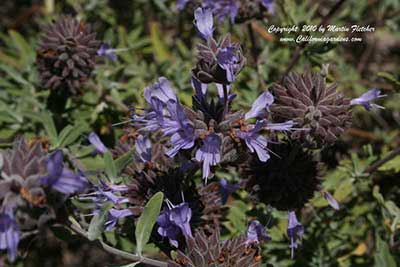
Flowers and foliage of Salvia Allen Chickering.
Salvia apiana, the White Sage has incredible fragrant white leaves. The foliage grows to 3-4 feet. The flowers an additional 2 feet or more. Bee Sage requires great drainage, and is extremely drought tolerant. The leaves and flower stalks of Salvia apiana are often used ceremonially.
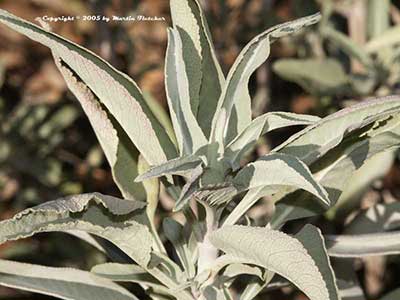
Fragrant white foliage of Salvia apiana, the White Sage.
Salvia brandegeei is native to Santa Rosa Island near Santa Barbara. The long dark green bumpy leaves of Brandegee's Sage are a great textural aspect of this sage even when it is not in flower. Salvia brandegeei grows to about four feet tall and wide with lavender blue flowers in the Spring.
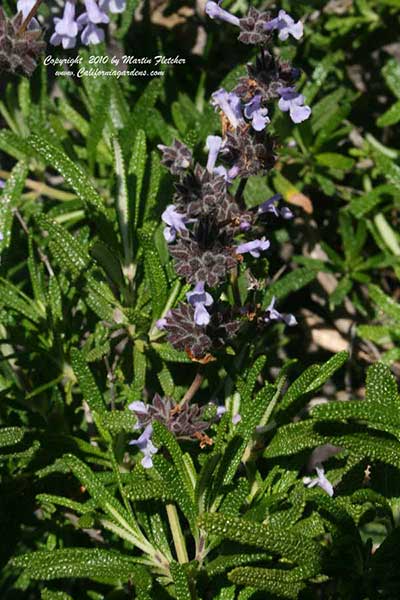
Flowers and foliage of Salvia brandegeei, Brandegee's Sage.
Salvia carduacea is an annual that is native to the dry inland portions of California. Thistle sage blooms in the middle spring months. Good soil drainage conditions are a must for Salvia carduacea to thrive in the home garden. Seed germinates in disturbed areas so the Thistle Sage can be added to your wildflower mix with some high likelihood of success.
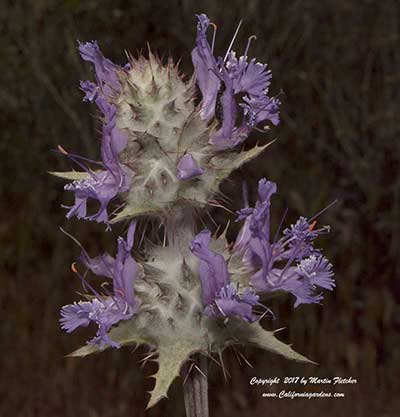
Flowers and foliage of Salvia carduacea, the Thistle Sage.
Salvia Celestial Blue is a hybrid sage that includes the parents, Salvia clevelandii, Salvia Pozo Blue and Salvia pachyphylla. Salvia Celestial Blue has some of the darkest blue flowers on a native sage. Salvia Celestial Blue grows to 5 feet or more tall and wide. The Celestial Blue Sage has fragrant flowers and foliage and has gray leaves, a dark red calyx, and those dark blue flowers.
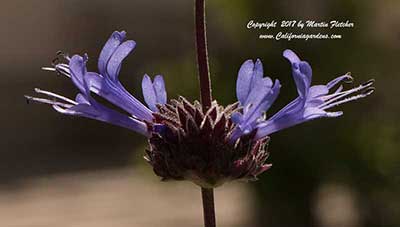
Flowers and foliage of Salvia Celestial Blue, Celestial Blue Sage.
Salvia clevelandii, the Blue Sage is one of the most fragrant native California sages. Salvia clevelandii gets to 3-4 feet tall and will continue to spread up to 6 feet or more if in a robust environment. Salvia clevelandii is one of the parents in many of the California native sage hybrids.

Flowers and foliage of Salvia clevelandii, Cleveland Sage or California Blue Sage.
Salvia clevelandii Winnifred Gilman is noted for the dark blue flowers and rich red calyx. The gray foliage is wonderfully fragrant. Salvia Winnifred Gilman is a selection from Salvia clevelandii. The Blue Sage typically grows to 4 feet tall and wide. Salvia clevelandii is native to the Southern Coast Ranges of California and Baja California. Salvia Winnifred Gilman is quite drought tolerant and requires reasonable drainage and breaks between irrigation cycles. The Blue Sage will survive Winter temperatures into the low 20°s.

Dark blue flowers and red calyx of Salvia clevelandii Winnifred Gilman, Winnifred Gilman Blue Sage.
Salvia columbariae, Chia is one of the more recognizable wildflowers. I have heard that if you could hold a handful of Chia seed you could live forever. There are some truths in that statement. Salvia columbariae seeds are small and they taste great. I have struggled to hold more than a few chia seeds before taking a snack. I feel energized after snacking on the seeds from a few flowerheads. I take the nearly dried clusters of dried flowers and upend them and tap them a few times in my palm. I often get 50 or more seeds per ripened head. Sometimes a few beetles shake out as well. Hey extra protien.
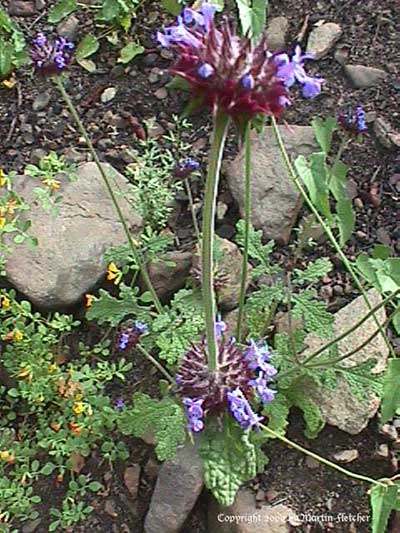
Flowers and foliage of Salvia columbariae, Chia.
Salvia sonomensis Dara's Choice is a hybrid between Salvia sonomensis and Salvia mellifera has wonderfully fragrant foliage as do all of the Black Sage relatives. The Dara's Choice Creeping Sage has medium blue flowers from the late Winter into Spring. Salvia sonomensis Dara's Choice is very compact, growing up to 1.5 feet tall and 4-5 feet wide, a quarter of the parent species Salvia mellifera. Salvia Dara's Choice is drought tolerant, prefers good drainage and a sunny position in the garden.
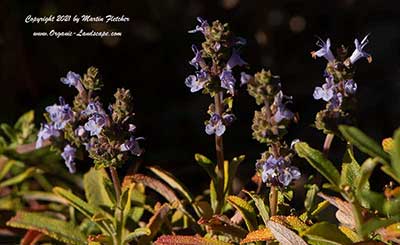
Blue flowers and green leaves of Salvia Dara's Choice, the Dara's Choice Creeping Sage.
Salvia Desperado is a robust hybrid resulting from a cross between the White Sage, Salvia apiana and the Purple Sage, Salvia leucophylla. Salvia Desperado grows vigorously with flower stalks reach to 6-8 feet or more. Or depending on the exposure spreading quite wide. The large white leaves from the white sage are showy. The lavender purple flowers are larger than any native sage cultivar I know. The flowers and foliage are very fragrant.

Lavender Pink Flowers of Salvia Desperado, the Desperado Sage.
Salvia dorrii, Purple Desert Sage is native to the deserts of California and the West from Arizona to Washington. Good drainage is a must. The red bracts contrast so vibrantly with the blue flowers. It is worth making the conditions work for the Purple Desert Sage. The gray leaves are a plus too. Salvia dorrii grows to about 2 feet tall and wide.
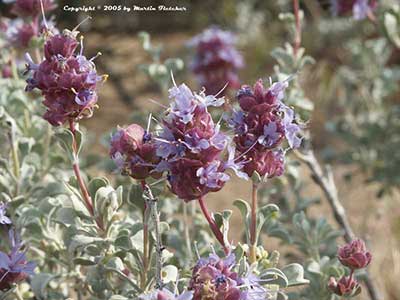
Flowers and foliage of Salvia dorrii, the Purple Desert Sage. High resolution photos are part of our garden image collection.
Salvia Green Carpet has wonderfully fragrant foliage as do all of the Black Sages and hybrids. The Green Carpet Creeping Sage has pale blue flowers from the late Winter into Spring. Salvia Green Carpet is compact, growing up to 2 feet tall and 4-5 feet wide, a third less than the parent species Salvia mellifera and similar is size but greener than Salvis sonomensis. Salvia Green Carpet is drought tolerant, prefers good drainage and a sunny position in the garden. Salvia mellifera is often mentioned as the best sage for making sage honey.
"
Pale blue flowers tucked into green leaves Salvia Green Carpet, the Green Carpet Creeping Sage.
Salvia leucophylla Amethyst Bluff is a selection of the Purple Sage from the coastal bluffs near Point Sal by Carol Bornstein. Salvia leucophylla Amethyst Bluff is notable for its pink flowers and for its vigorous growth, particularly in near coastal garden. Salvia leucophylla Amethyst Bluff can reach 10 feet tall and as much as 15 feet wide.
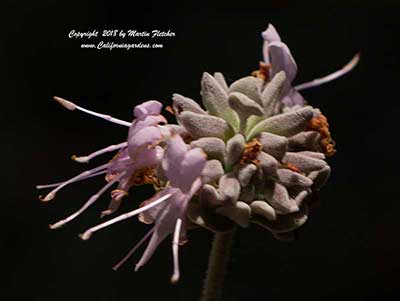
Pink Flowers of Salvia leucophylla Amethyst Bluff, the Amethyst Bluff Purple Sage.
Salvia leucophylla Bee's Bliss is a hybrid of a couple of California native sages, Salvia leucophylla Point Sal and either Salvia clevelandii or Salvia sonomensis. Salvia leucophylla Bee's Bliss is noted for spreading lower and more compactly than Salvia leucophylla Point Sal. Salvia leucophylla Bee's Bliss grows to 8 feet or more in width and stays with a foot to 18" in height.
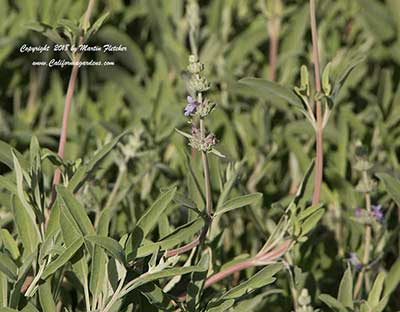
Flowers and foliage of Salvia Bee's Bliss, the Bee's Bliss Sage
Salvia leucophylla Point Sal, Purple Sage, Point Sal is a selection that stays comparatively low. It typically only gets to 3' tall but can get to 10 feet or more wide. The foliage is quite fragrant. Salvia leucophylla Point Sal is marketed as an erosion control and low fire risk native plant. There are newer hybrids that say lower and may be a better choice in a high fire risk area. Regardless of that, this plant has been a parent for many of those hybrids.
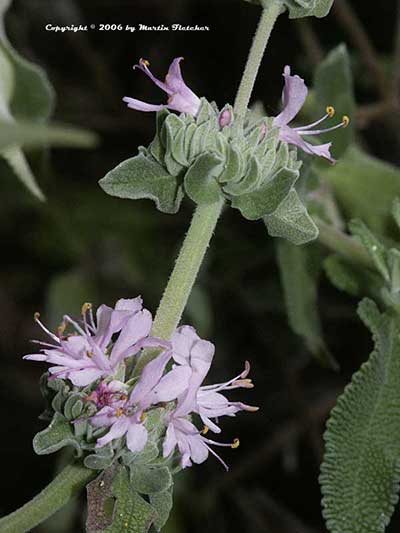
Flowers and foliage of Salvia leucophylla Point Sal, Purple Sage selection.
You can smell the foliage oils of Salvia mellifera as you walk by without even touching the plants. This scent brings back childhood memories of running down trails hurdling the branches that stuck out over the trail. The pale blue to white flowers stand out when they are visible against the dark bumpy leaves. In the garden setting care must be taken not to water too much in the summer. Salvia mellifera can withstand winter rainfall but not living in a bog. Naturally the Black Sage is found on South and West facing slopes on rocky soil in California's coastal sage scrub plant community. Many think that Black Sage is the best source plant for sage honey.

Flowers and foliage of Salvia mellifera, Black Sage.
Salvia mellifera Skylark has wonderfully fragrant foliage. The Skylark Sage has rich blue flowers from the late Winter into Spring. Salvia mellifera Skylark is compact, growing up to 2 feet tall and 4 feet wide, a third less than Salvia mellifera which is the one known parent of the garden selected sage. Salvia mellifera Skylark is drought tolerant, prefers good drainage and a sunny position in the garden. Salvia mellifera is often mentioned as the best sage for making sage honey.
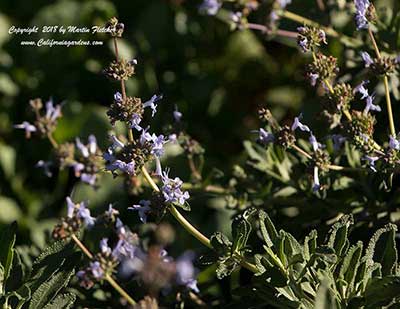
Blue flowers and green leaves of Salvia mellifera Skylark, the Skylark Sage.
Salvia mellifera Terra Seca, Dwarf Black Sage has wonderfully fragrant foliage. Salvia mellifera Terra Seca is a low growing wild sellection with white flowers and dark green leaves. Rating a plant for fire danger is partly due to the volatility of the material and partly due to the volume of air within the plant when fire is present. A prostrate variety like Salvia mellifera Terra Seca is going to be less of a fire hazard because the plants are lower to the ground. A five year old plant is 18" tall in one of our gardens and has spread to 8 feet in diameter. Salvia mellifera Terra Seca is hardy into the teens. Salvia mellifera is often mentioned as the best sage for making sage honey.
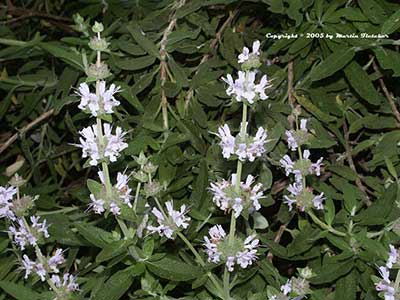
White flowers and green foliage of Salvia mellifera Terra Seca, Dwarf Black Sage.
Salvia Mrs. Beard is a hybrid between Salvia sonomensis and Salvia mellifera has wonderfully fragrant foliage as do all of the Black Sage relatives. The Mrs. Beard Creeping Sage has pale blue flowers from the late Winter into Spring. Salvia Mrs. Beard is compact, growing up to 2 feet tall and 4-5 feet wide, a third less than the parent species Salvia mellifera. Salvia Mrs. Beard is drought tolerant, prefers good drainage and a sunny position in the garden.
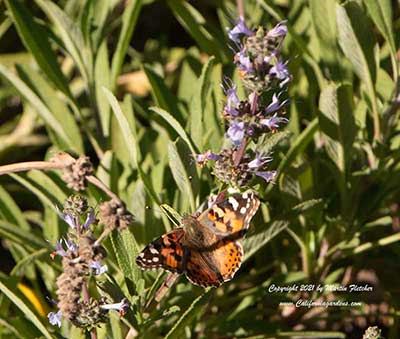
High resolution photos of Salvia Sonomensis Mrs Beard, the Mrs Beard Creeping Sage are part of our garden image collection.
Salvia munzii is a compact shrubby California Native Sage with grey-green leaves and lavender flowers in Spring. The San Diego Sage is rare on the northern side of the border but more common in Baja. Salvia munzii typically grows a couple of feet high and 3-4 feet wide. Note that Munz's Sage comes from dry habitat and when given a moister setting it will likely grow larger. Salvia munzii is drought tolerant and does best with a full sun location in the garden. As with many of the California native sages Salvia munzii will not be the first plant in the garden to be eaten by deer or rabbits.
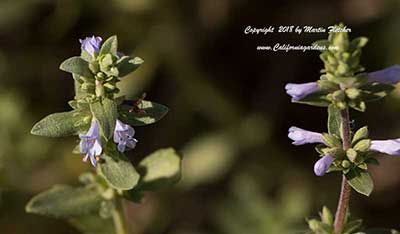
Lavender flowers and grey-green leaves of Salvia munzii, the San Diego Sage, Munz's Sage are part of our garden image collection.
Salvia munzii Emerald Cascade is a compact shrubby California Native Sage. Salvia munzii Emerald Cascade is a low growing selection with vibrant green foliage and blue flowers. Salvia munzii Emerald Cascade typically grows up to a couple of feet high and 3-4 feet wide. Note that Munz's Sage comes from dry habitat and when given a moister setting it will likely grow larger in a garden setting. Salvia munzii Emerald Cascade is tolerant of clay soils in a dry environment. Salvia munzii Emerald Cascade is drought tolerant and does best with a full sun location in the garden. As with many of the California native sages Salvia munzii Emerald Cascade will not be the first plant in the garden to be eaten by deer or rabbits.

Blue flowers and emerald green leaves of Salvia munzii Emerald Cascade, the San Miguel Mountain Sage, Munz's Sage.
Salvia Pozo Blue, Grey Musk Sage is a hybrid between Salvia clevelandii and Salvia leucophylla and has many of the best attributes of both. Salvia Pozo Blue is more compact than Salvia Allen Chickering and grows to 3-4 feet tall in our gardens and 6 feet wide. The Salvia Pozo Blue is quite fragrant and has grey-green foliage yielding a descriptive Grey Musk Sage common name. The lavender blue flowers come on in late Winter and continue into Spring. Salvia Pozo Blue should be grown in full sun with good drainage. The Grey Musk Sage is quite drought tolerant once established. Salvia Pozo Blue is Winter hardy into the low 20° F.
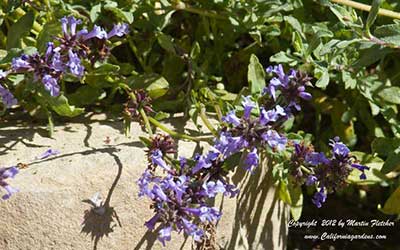
Lavender blue flowers and foliage of Salvia Pozo Blue, Grey Musk Sage. High resolution photos are part of our garden image collection.
Salvia spathacea is one of the first plants to bloom in the Oak Woodland each winter. The list of plants that can grow well under oak trees is limited because shade plants often require more water than the oak's roots can survive. Because Hummingbird Sage is a natural component of the oak woodland it can thrive on what makes other plants wilt. Salvia spathacea does look better with a little additional summer water but not so much that it might damage the Oaks. I water when there are cool cycles between the heat spells. In this case a little goes a long way. The natural analogue to this irrigation would be fog drip off the trees. Problems with the plants often relate to hot weather and excess water with inadequate drying between watering cycles. Other common names that are applied to this plant are Crimson Sage and Pitcher Sage.
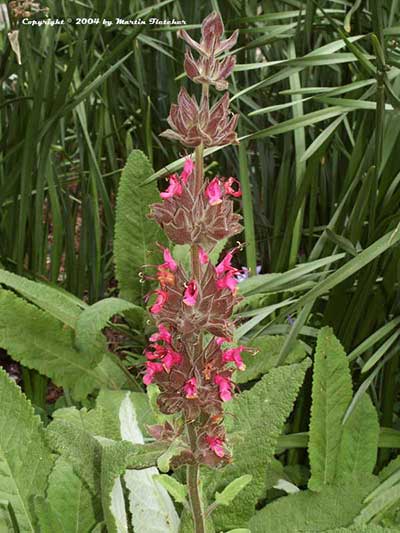
Flowers and foliage of Salvia spathacea, Hummingbird Sage.
